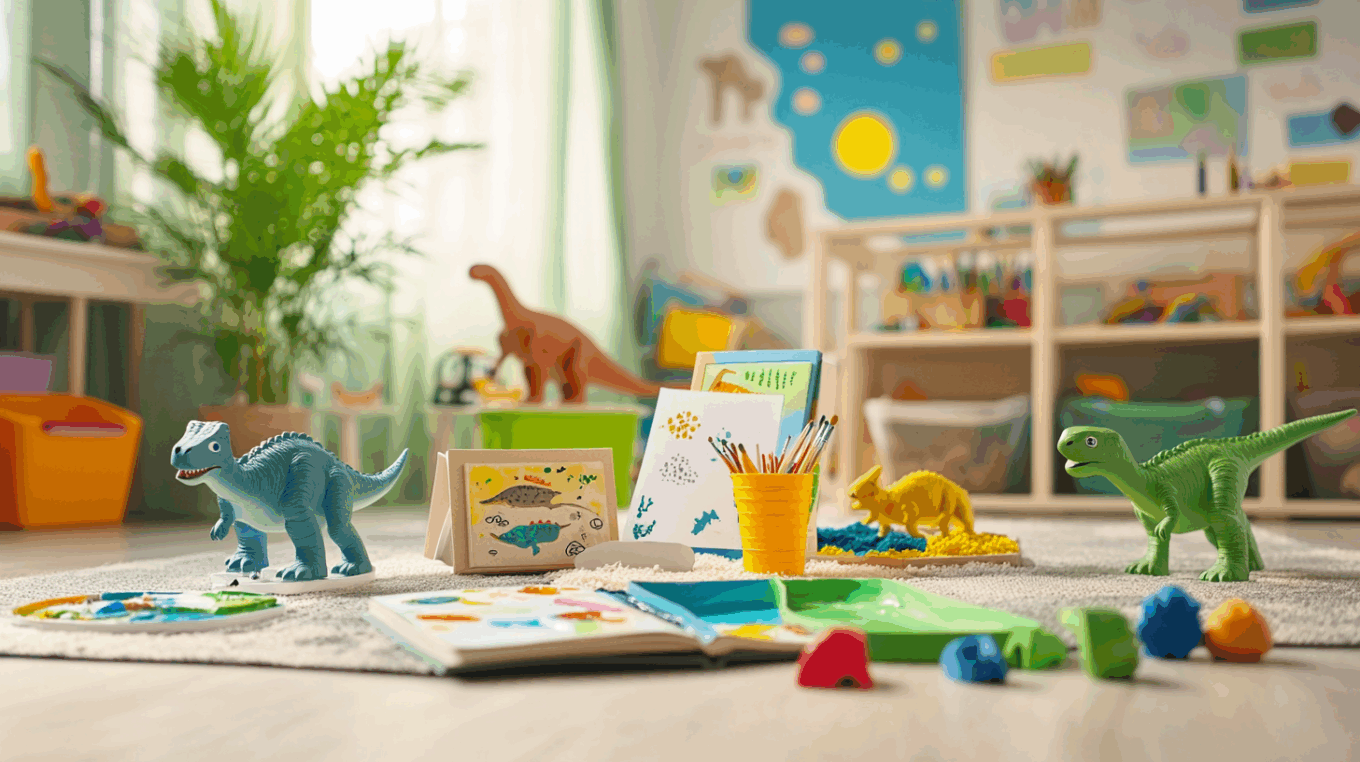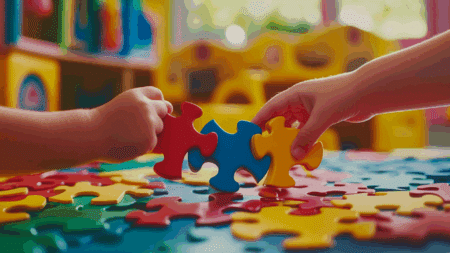Toddlers love dinosaurs because they are big, interesting, and mysterious.
When kids are restless and have short attention spans, dinosaur activities are a great way to keep them busy.
These activities turn play into learning moments that help kids develop important skills while having fun.
From sensory bins with hidden fossils to colorful crafts and counting games, dinosaur play mixes learning with fun in ways kids enjoy.
This blog offers simple and affordable ideas using things you probably already have at home. Ready to turn boredom into excitement? Let’s see how dinosaur play can help your child grow.
Benefits of Dinosaur Activities for Toddlers
Dinosaur-themed activities are magical gateways to early childhood development, changing simple play into powerful learning experiences.
These prehistoric adventures offer far more than just entertainment, becoming essential tools for young minds to grow, learn, and understand the world around them.
Boosting Early Learning Skills
Learning becomes an exciting journey when dinosaurs enter the picture.
Sorting colorful toy dinosaurs helps toddlers master color recognition, while counting prehistoric creatures turns numbers into thrilling adventures.
Simple games featuring dinosaurs introduce letters and numbers in ways, make education feel like an extraordinary activity.
Developing Fine Motor Skills
Small dinosaur-related activities work wonders for hand strength and coordination.
Carefully moving tiny figurines, tracing dinosaur shapes, and creating scenes with playdough require precision that naturally develops fine motor skills.
Each interaction becomes a chance to improve dexterity, with toddlers hardly noticing they’re building crucial physical abilities.
Sparking Creativity and Imagination
Dinosaur play opens up endless worlds of creative expression. Painting with dinosaur toys, building prehistoric landscapes with Magnatiles.
Moreover, crafting stories with prehistoric characters allows children to use their imagination.
These activities encourage storytelling, spatial reasoning, and emotional expression, changing simple play into learning experiences.
Dinosaur Story Time

1. Dinosaur Book Exploration
Read dinosaur books like ‘How Do Dinosaurs Say Goodnight?’, ‘Dinosaurumpus’, and ‘Never Touch a Dinosaur’ for better imagination.
Create a cozy reading nook with pillows and dinosaur toys. Use different voices for characters and ask simple questions to build comprehension skills and keep your little one engaged throughout the story.
2. Create Your Dino Tales
Encourage your toddler to come up with their own dinosaur stories. Use dinosaur toys as characters and let your child dictate the story to you.
Act out the adventures and discuss what each dinosaur is doing to create a more interactive experience.
Sensory Play Adventures

3. Prehistoric Sensory Treasure Hunt
Fill a container with rice, kinetic sand, or shredded paper. Hide dinosaur toys and fossil replicas inside for discovery. Provide tools like magnifying glasses and paintbrushes for little paleontologists.
Add small rocks and sticks for realistic texture. Use caution tape to mark “excavation sites” around your play area.
This sensory activity develops fine motor skills while introducing scientific concepts.
4. Ice Age: Dino Rescue
Use balloons or containers to freeze small dinosaur toys in water. Add food coloring before freezing for visual interest.
Let your toddler experiment with warm water, salt, and safe tools to free the frozen dinosaurs.
Talk about how scientists study ice samples to learn about ancient climates and how dinosaurs lived in different environments long ago.
5. Muddy Dino Dig
Mix cocoa powder with flour and a little water to create taste-safe “mud.” In a shallow bin, hide dinosaur figures throughout the mixture.
After digging and discovering, set up a washing station with soapy water and brushes. This two-part activity naturally introduces the concepts of “dirty” and “clean” while providing rich sensory input for developing brains.
Hands-On Learning Fun

6. Dino Spike Clipping Game
Cut dinosaur silhouettes from sturdy cardboard. Show your toddler how to attach clothespins along the dinosaur’s back to create spikes.
This pinching motion strengthens the small hand muscles needed later for writing. For older toddlers, write numbers on the dinosaur’s back.
Then, match the numbers on clothespins for additional learning through matching and counting.
7. Dinosaur Name Match-Up
Gather dinosaur figurines and create simple matching cards with pictures and names. Start with just three or four easier dinosaurs before adding more challenging ones.
Guide your child in matching each toy to its corresponding card while discussing distinctive features – long necks, horns, plates, or sharp teeth.
This activity builds vocabulary and visual discrimination skills.
Arts and Crafts with Dinosaurs

8. Dino Stomp Painting
Pour washable paint onto shallow trays in various colors. Show your toddler how to dip dinosaur feet into paint and press them onto paper, creating realistic-looking tracks.
Try different colors for each dinosaur to track their paths. After making prints, use paint-covered dinosaurs as brushes to create swirls and textures for open-ended artistic expression.
9. Jurassic Footprint Art
Use larger dinosaur figures with distinctive feet to create dramatic footprints with washable paint.
After making several dinosaur prints on large paper, help your toddler add their own footprints alongside for comparison.
This creates opportunities to discuss size differences, count toes, and talk about how scientists use footprints to learn about extinct animals.
10. Craft Stick Dino Friends
Turn craft sticks into charming dinosaur puppets. Draw simple faces using markers or attach googly eyes.
Using school glue, add construction paper features zigzag spikes, long necks, or frills, to the puppets. Once dry, these puppets become versatile props for creative storytelling.
Create a simple puppet theater using a box with the bottom cut out for dinosaur performances.
11. Watercolor Dinosaur Fun
Draw simple dinosaur outlines on watercolor paper. Set up paints with child-sized brushes and demonstrate the wet-on-wet technique.
Let your toddler fill in the shapes with colors of their choice. Sprinkle salt onto wet areas to create a crystallized texture resembling dinosaur skin.
Frame finished artwork for room decoration that celebrates your child’s creativity.
Play-Based Learning Activities

12. Color Match Dino Game
Create color stations using construction paper in primary and secondary colors. Gather dinosaur toys in corresponding colors or label them with colored stickers.
Guide your toddler in matching each dinosaur to its color home. Create a story about dinosaurs finding their matching islands.
For an additional challenge, add letters or shapes to match as well.
13. Dinosaur Egg Number Puzzle
Cut oval “egg” shapes from cardstock. Cut each egg in half with unique wavy lines. Write a numeral on one half and draw the corresponding number of dots on the matching piece.
Laminate for durability. Challenge your toddler to match the number to the correct quantity of dots.
The unique cuts provide self-correction as only matching pieces fit together.
14. Magnetic Dino Builders
Use magnetic building tiles to create dinosaur shapes on vertical metal surfaces like refrigerators. Show your child pictures of simple dinosaur silhouettes for inspiration.
The vertical building develops different muscles than table activities. Talk about shapes used: triangles for heads, rectangles for bodies.
The magnetic properties allow easy repositioning for frustration-free creation.
15. Shapes and Dino Patterns
Create pattern cards showing sequences using dinosaur silhouettes or colors.
Place small dinosaur figures in patterns for your child to continue – try big/small, standing/lying down, or color patterns.
Start with simple AB patterns before introducing more complex sequences. Explicitly describe patterns as you build them.
This early math foundation develops logical thinking skills and pattern recognition.
Action-Packed Dino Games

16. Roaming Dinosaur Hunt
Hide toy dinosaurs around your home or yard, placing them at different heights to encourage various movements. Give your toddler a basket or wagon for collecting.
Begin with a simple story about escaped dinosaurs needing to be found. When all are discovered, count them together, reinforcing the number sequence.
Create a picture map for older toddlers showing dinosaur locations.
17. Dinosaur Egg Discovery
Create “dinosaur eggs” by encasing small figures completely in playdough. Use two colors twisted together for a marbled effect.
Provide tools like plastic knives or craft sticks for careful excavation. As dinosaurs emerge, talk about how real dinosaurs hatched from eggs similar to modern reptiles and birds.
This activity develops fine motor control while introducing prehistoric life cycles.
18. Bubbly Dino Wash
Fill a small tub with warm water and gentle soap for bubbles. Provide sponges, soft brushes, and small cloths for scrubbing.
Frame the activity as a “dinosaur spa” for added pretend play. Add a drying station with towels where cleaned dinosaurs can rest.
This water play naturally incorporates concepts of clean and dirty while providing valuable sensory stimulation.
Tips for Setting Up Dinosaur Activities at Home
Making dinosaur activities at home is easier than you think! With a few simple tools and some creativity, you can set up playful learning spaces your toddler will love.
Here are helpful tips to make things fun and safe.
Use What You Have
- Look around your home for items that work perfectly for dinosaur play.
- Kitchen trays make great sensory bins.
- Plastic containers store small dinosaur toys.
- Old paintbrushes work for fossil cleaning.
- Paper towel tubes become dinosaur binoculars.
- Measuring cups and spoons are excellent for sensory play.
- This approach saves money and teaches children creativity with everyday objects.
Keep it Open-Ended
- Avoid giving step-by-step instructions for every activity.
- Set up materials and let your toddler learn in their own way.
- They might use dinosaurs for painting instead of making footprints, and that’s okay!
- Follow their lead and ask questions about what they’re creating.
- Open-ended play builds problem-solving skills and confidence.
- Children learn more when they make their own choices.
- Watch how they use materials in surprising and creative ways.
Safe Materials
- Always choose non-toxic, washable materials for toddler activities.
- Check for small parts that could be choking hazards, especially in sensory bins.
- Stay within arm’s reach during water play and activities with small items.
- Use taste-safe options like flour and cocoa powder for younger toddlers.
- Test all materials yourself before introducing them to your child.
- Have cleanup supplies ready for messy play.
- Create clear boundaries about where messy play can happen.
Wrapping Up
Dinosaur activities for toddlers give children much more than just entertainment; they provide valuable learning opportunities wrapped in prehistoric fun.
By incorporating these simple ideas into your routine, you’ll help develop your child’s fine motor skills, early math concepts, language abilities, and creative thinking.
Remember to use materials you already have, keep activities open-ended, and prioritize safety above all.
The most important aspect isn’t perfection but the quality time spent playing and learning together.
Start small with one activity, and watch how your toddler’s eyes light up with curiosity and joy.
These dinosaur activities for toddlers might just become your secret weapon for meaningful childhood development.




